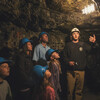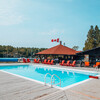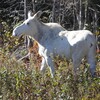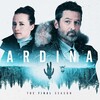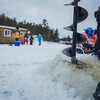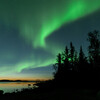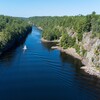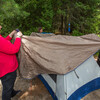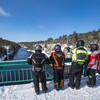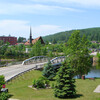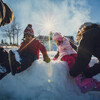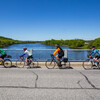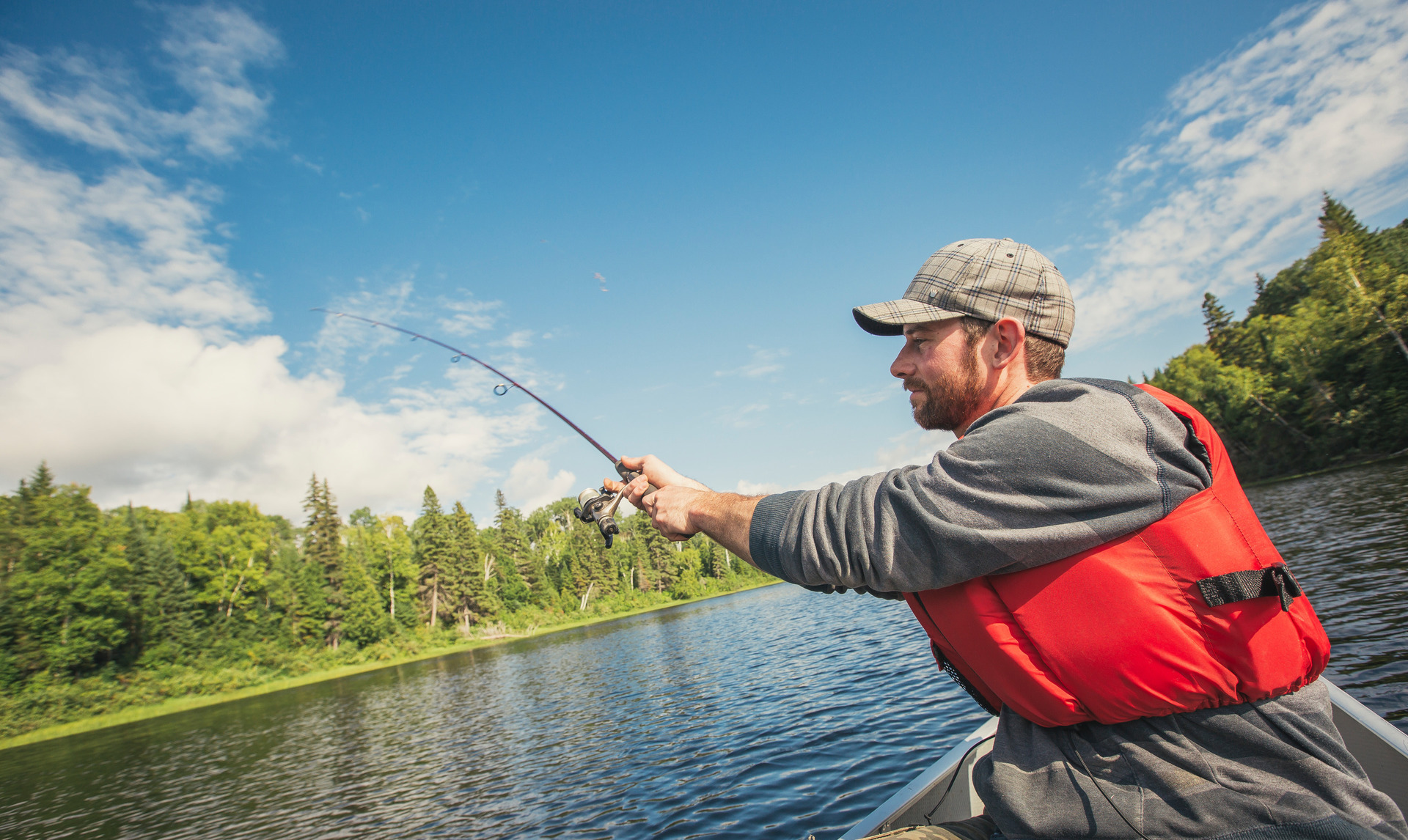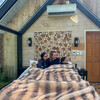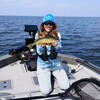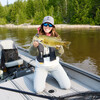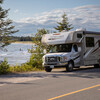
Fantastic Fall Bass (and Why You Need a Dutch Oven!)

I was lucky enough to get out into the woods and on the water a few times before winter hit. Late fall is my favourite time of the year to be out, just before the bass fishing shuts down for the year. The nights are cool but the days are usually sunny and warm. Northern pike and smallmouth are getting chunky and easier to catch.
I usually choose slow moving rivers to paddle, camp and fish. They’re also the last to freeze up. The Lower French and Temagami/Marten River area are all great spots.
Further to the northeast I like the Mattagami, Minisinakwa, Grassy or Nabakwasi Rivers. They provide endless places to pitch a tent and cast a line.
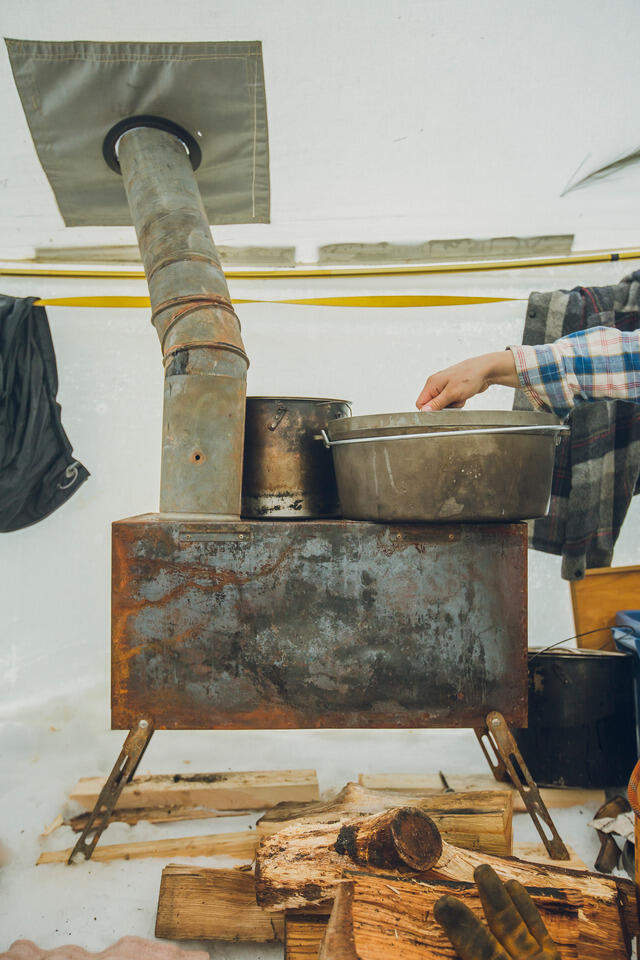
The only true disadvantage of late season camping, however, is the lack of daylight. It’s dark before 6:00 pm, leaving lots of time to hang around camp waiting for the sun to rise again. Another reason that packing a heated tent is the way to go. I’ll sit by the wood stove, sip single malt, read a book, and cook a good meal.
One of the best ways to cook a delicious meal while out fall camping is to use the traditional Dutch oven. It turns those who try it into absolute die-hard fans.
So why the popularity? After all, it’s heavy and bulky. The answer is simple—whatever is cooked in it tastes fantastic; and it cooks just about everything. Imagine, on a long, cold night cooking up a stew or chilli and corn bread. It’s an absolute dreamscape.
The Dutch oven originated in Holland around the early 1700s and has been widely used around the world ever since. George Washington fed his troops with it and Lewis and Clark cooked up horse stew on their historic trek to the west coast. It was used to for baked beans during the cattle drives and sourdough bread during the Klondike gold rush. Military camps used it during World War I and, by the 1970s, it had become one of the top choices for campers to cook a meal.
The Dutch oven is also called a camp oven, outdoor oven, kitchen oven and bean pot. The bean pot and kitchen oven are basically the same design, equipped with a rounded lid, flat bottom and no legs. These are generally used at home and in the oven. The camp oven and outdoor oven are derived from a different style with a flanged lid, flat bottom, with three legs, and a steel bail handle for carrying. This is the style used for camping, with the flanged lid designed for holding hot coals and the legs used to hold the pot above the campfire embers.
Dutch ovens are commonly made from cast iron. The material distributes heat evenly and retains heat, which is why the oven is so effective. The solid lid seals the pot, keeps in the moisture, and steams the contents, keeping the food tender. Cast iron is also long lasting and can literally be passed down from generation to generation.
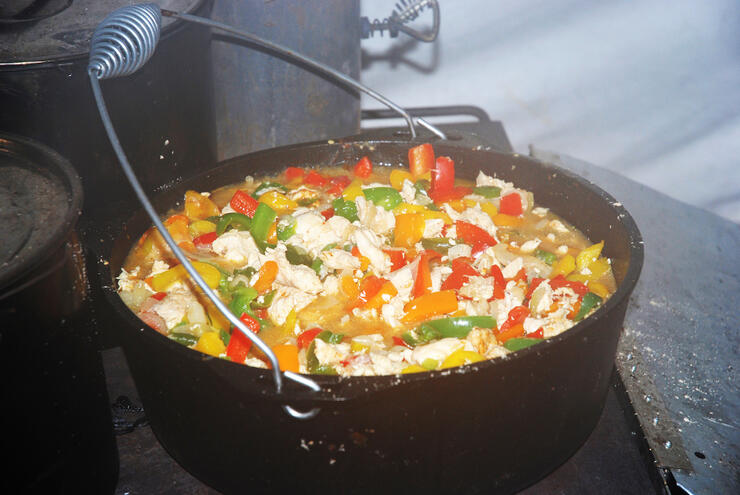
To cut down in weight, there are aluminum Dutch ovens available. This is definitely an added bonus for anyone wanting to pack it along on an interior trip. Many traditionalists slam the use of the aluminum but the weight difference is significant - cast iron weighs in at 18 lbs and an aluminum model weighs a mere 7 lbs. Aluminum also doesn’t rust and can be washed easily with soap and water. Some models come with a non-stick coating. Aluminum also doesn’t discolor the food like cast iron. The pot heats up quicker as well, which can actually be more of a disadvantage. The heat has a tendency to fluctuate too much—it's far easier to burn your meal in an aluminum oven than in a cast iron.
Whichever one you decide to purchase, make sure the lid fits snug to create a good seal but that it can be moved slightly from side to side. If it’s a cast iron model, give it a good wash with soap, water and scrub brush. Most cast iron manufacturers place an edible protective wax coating to stop it from rusting during shipment. Right after you wash the Dutch oven, it’s time to season it with vegetable shortening. After this point, soap is never to be used while washing the Dutch oven. The oven must be continually seasoned. Cast iron is incredibly porous, like a sponge, and the cooking oil fills the its fine holes. Aluminum ovens also benefit from the seasoning process even though aluminum doesn’t rust like iron, but it does oxidize so adding a layer of oil will prevent that from happening.
Rub the shortening on the entire surface area of the cast iron. Then heat it up in your kitchen oven, your barbecue, or a campfire. The seasoning step is a stinky and smoky job (but an important process), so you’re best choosing the outside options. Oil is continually added throughout the use of the oven and eventually you’ll create a non-stick surface.
Try this Dutch oven recipe from my book The New Trailside Cookbook.
Breakfast Cornbread
Cooking up cornbread in a Dutch oven while sipping on morning coffee and stoking the wood stove inside a cozy canvas tent has to be one of the greatest moments while winter camping. Of course, you might have to substitute the pancake syrup with some dark rum if the cold temperature freezes the syrup. Egg powder also doesn’t freeze solid the way an egg does at -20 degrees Celsius.
2 tbsp granulated sugar
1/4 tsp each ground ginger, cinnamon and nutmeg
2 cups milk
1/4 cup cornmeal
1 egg
1/4 cup pancake syrup
At home: Combine sugar, ginger, cinnamon and nutmeg; store in a small sealed plastic bag.
Camping tip: This bread will need to be cooked with coals both on top of and under the Dutch oven.
There you have it—if you don’t already own a Dutch oven and you’re an avid camper, especially late fall and winter camping, be sure to get yourself one, or maybe even add it to your Christmas wish list!
Recommended Articles
The Seven's Best Hikes, Biking Trails and Lakes

7 Best Spots to Check Out in The Seven

Budget Bliss: Explore Northeastern Ontario Without Breaking the Bank

Bring Your Fam!

Time to Unwind: 6 Spa Havens to Discover In The Seven
5 Amazing Places to SUP in Northeastern Ontario

5 Amazing Bike Rides to Discover

Northern Lights in Northeastern Ontario

Northeastern Ontario's Best Pride Festivals

Fish for one of the World's Rarest Species of Trout

An Insider's Guide to Manitoulin Island

6 Small-Town Gems to Explore in Northeastern Ontario

11 Best Things to Do in Kapuskasing, Ontario

